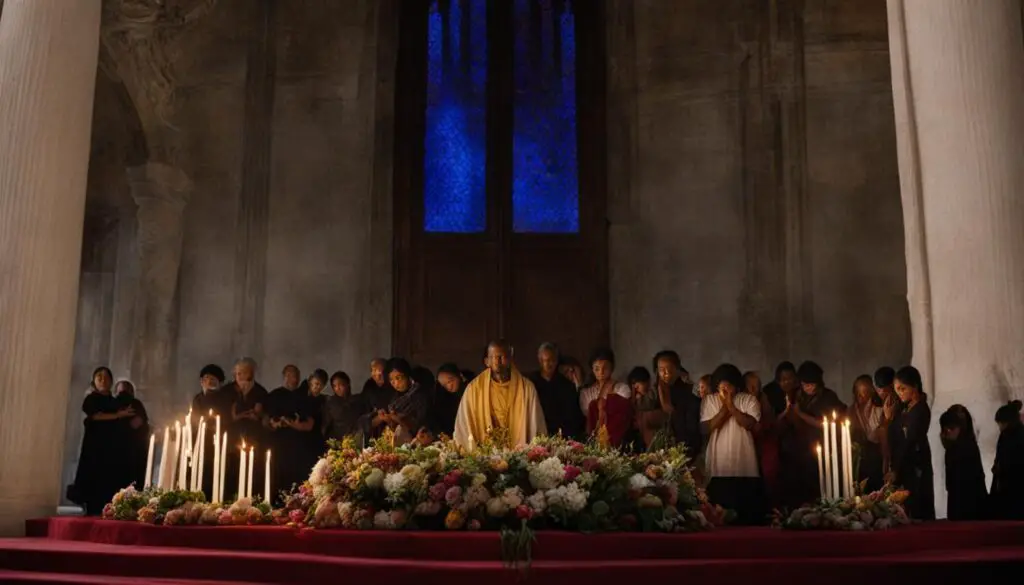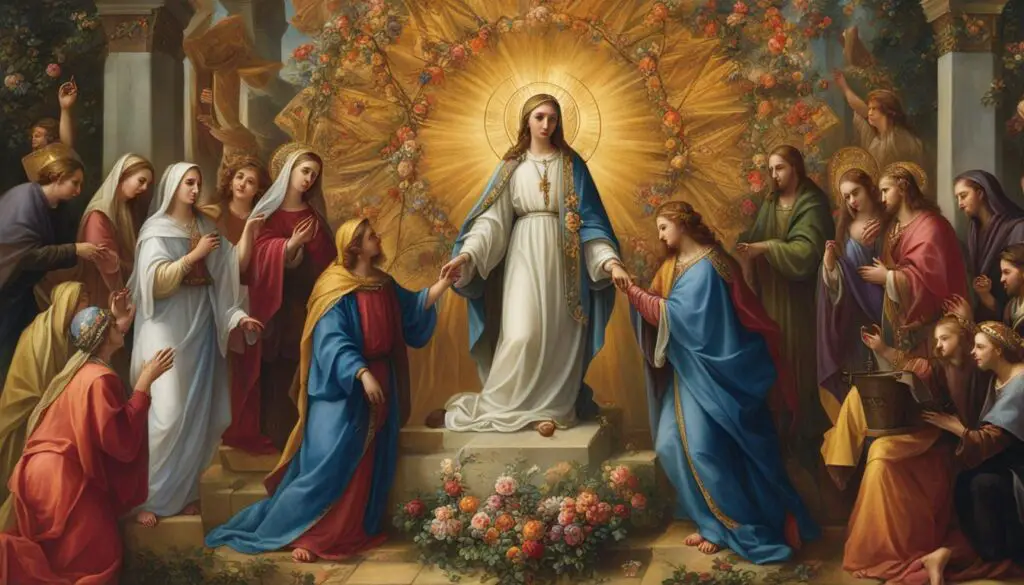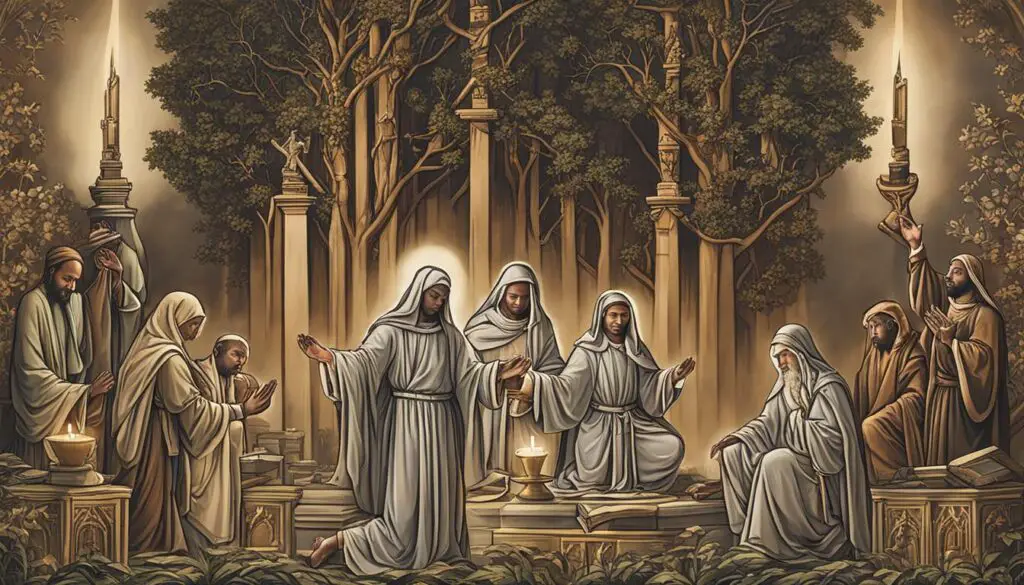Prayers of tradition have a timeless and profound impact on personal spirituality and collective faith in the United States. These ancient prayers, handed down through generations, encompass a rich tapestry of traditional prayer rituals, sacred practices, and spiritual connections. Rooted in religious traditions, they offer a glimpse into the past, providing a sense of continuity and deepening our understanding of our shared heritage.
Traditional prayers connect individuals to the wisdom and spirituality of their ancestors. They serve as a bridge between the past and the present, offering guidance, solace, and inspiration. These prayers invoke a sense of reverence and provide a sacred space for introspection and growth.
Key Takeaways:
- Prayers of tradition hold immense power in personal spirituality and collective faith.
- They connect individuals to their heritage and offer a sense of continuity with the past.
- These prayers serve as a sacred space for introspection, growth, and spiritual connection.
- They provide guidance, solace, and inspiration in the midst of life’s challenges.
- Traditional prayers deepen our understanding of our shared religious heritage and foster a sense of community.
Understanding the Different Forms of Traditional Prayer
In the realm of traditional prayer, the sacred practices and customs deeply rooted in religious traditions provide a diverse array of ways to connect with spirituality and express devotion. These traditional prayer forms encompass various rituals and expressions that foster a profound connection with the divine. Let us explore some of these different forms of prayer:
1. Intercession Prayers
Intercession prayers hold a significant role in traditional prayer practices. These prayers involve lifting up supplications on behalf of others, appealing to a higher power for their well-being, guidance, and protection.
2. Thanksgiving Prayers
Expressing gratitude to the divine is essential in traditional prayer. Thanksgiving prayers focus on acknowledging and appreciating the blessings bestowed upon individuals. They offer an opportunity to reflect on the abundance and grace received from the divine.
3. Blessing, Adoration, and Petition
Blessing prayers entail responding to God’s blessings and offering praise. Adoration prayers contemplate the divine’s grandeur and express reverence and awe. Petition prayers involve presenting heartfelt requests to the divine, seeking guidance, healing, and support.
These different forms of prayer enable individuals to engage with their spirituality in a profound and personal way, fostering a deeper connection with the divine. Each form provides a unique avenue for expressing devotion, seeking solace, and deepening spiritual growth.

By incorporating these forms of traditional prayer into their spiritual practice, individuals can embark on a transformative journey of self-discovery, gratitude, and connection to something greater than themselves.
All Souls’ Day: Honoring the Departed Through Prayer
All Souls’ Day, observed on November 2nd, is a sacred time for Catholics to remember and pray for their departed loved ones. It is a solemn occasion that holds deep significance in Catholic tradition, symbolizing the commemoration and remembrance of those who have passed away. On this day, Catholics gather in churches to attend special Masses and services dedicated to prayers for the departed.
With hearts filled with love and compassion, Catholics offer supplications for the souls of their departed loved ones. It is believed that these prayers hold the power to assist the souls in purgatory on their journey towards eternal peace and salvation. Through the act of prayer, Catholics seek to express their care, support, and enduring connection to those who have gone before them.
“Pray, hopeful hearts, within the veil, and be at rest” – John Greenleaf Whittier
In the Catholic tradition, All Souls’ Day provides an opportunity to honor the memory of the departed and to keep their legacy alive. This sacred day transcends time and offers a spiritual bridge between the living and the deceased. It serves as a reminder of the unconditional love and eternal bond shared with departed loved ones.
To further demonstrate their reverence, Catholics often offer memorial gifts as tangible symbols of remembrance and spiritual connection. Candles, flowers, and donations are among the meaningful offerings that honor the departed and express the ongoing bond between the living and those who have passed away.
| Symbolic Memorial Gifts | Meaning |
|---|---|
| Candles | A symbol of light and hope, representing the spiritual presence of the departed |
| Flowers | Serve as a beautiful tribute, symbolizing the love and appreciation for the departed |
| Donations | A way to honor the memory of the departed through charitable acts and contributions to meaningful causes |

On All Souls’ Day, Catholics find solace and comfort in prayer, knowing that their devotion and remembrance can have a profound impact on the journey of their departed loved ones. Through their acts of prayer and the offering of memorial gifts, they honor the departed, celebrate their lives, and keep their memory alive within their hearts.
The Power of the Rosary in Tradition and Contemplation
The Rosary holds a prominent place in the tradition of prayer. It combines simplicity and depth, making it a compendium of the Gospel message. The practice of the Rosary enables believers to contemplate the face of Christ, experience His love, and find solace and strength.
It is a tool for fostering peace and deepening devotion to the family. The repetition of the Hail Mary and meditation on the mysteries of the Rosary create a profound connection with God, allowing His peace to flow into the hearts and minds of individuals.
The Rosary serves as a means of unity in the pursuit of peace and as a source of inspiration for building strong family bonds rooted in faith and love.

Through the Rosary, families can come together to pray, share their faith, and grow closer to God. It provides a dedicated time for reflection, allowing family members to support and uplift one another in prayer.
The contemplative nature of the Rosary encourages individuals to enter into a deep state of reflection and silence, fostering a sense of inner peace and connection with the divine.
“The Rosary is the ‘weapon’ for these times.” – Saint Padre Pio
Saint Padre Pio’s quote highlights the transformative power of the Rosary in bringing about spiritual growth and inner peace. The repetition of prayers and meditation on the mysteries of Christ’s life allow individuals to enter into a state of contemplative prayer, leading to a deeper understanding of themselves and their relationship with God.
Additionally, the Rosary has the ability to create a sense of peace in turbulent times. It serves as a refuge for those seeking solace and comfort, providing a source of strength and hope.
The Rosary in History
The Rosary has a rich history dating back to the 12th century. It has been embraced by various religious orders and has played a significant role in the spiritual lives of countless individuals throughout the centuries.
One of the most notable instances of the Rosary’s power and devotion is the Battle of Lepanto in 1571. Pope Pius V called for the faithful to pray the Rosary for victory against the invading Ottoman Empire. The Christian fleet, vastly outnumbered, emerged victorious, attributing their success to the intercession of the Blessed Virgin Mary through the Rosary.
| Year | Event |
|---|---|
| 1214 | Our Lady of the Rosary appeared to Saint Dominic |
| 1917 | The Virgin Mary appeared to three shepherd children in Fatima and emphasized the importance of praying the Rosary |
| 2002 | Pope John Paul II introduced the Luminous Mysteries, adding an additional set of mysteries to the Rosary |
The Rosary continues to be a cherished tradition in the Catholic Church and is considered a powerful spiritual practice respected across Christian denominations.
Reviving the Rosary in Modern Times
In a fast-paced world, the revival of the Rosary offers an opportunity to prioritize contemplation and silence. The practice cultivates a deeper prayer life and spiritual growth. By meditating on the mysteries of the Rosary, individuals engage in a profound dialogue with God, seeking His guidance, peace, and presence.
The revival of the Rosary can contribute to the formation of authentic “schools of prayer” within Christian communities, where individuals can learn, share, and grow in their understanding and practice of prayer. Christians in the Reformed, Evangelical, and Pentecostal traditions emphasize spontaneous prayers that arise from the heart. Additionally, there are those who find the deepest form of prayer to be silent and wordless, cultivating the “attention of the heart” through practices like centering prayer.

The Diversity of Christian Prayer Practices
Within the Christian faith, prayer takes on various forms and practices that cater to both communal and individual experiences. It encompasses different postures, settings, and styles, allowing believers to connect with God in their own unique ways.
Postures of Prayer
In Christian prayer, individuals have the freedom to choose postures that resonate with their spirituality. Some may kneel as a sign of reverence and humility, while others may prefer standing or sitting. These physical postures can enhance focus and create a sacred space for communion with God.
Types of Prayer Settings
Christian prayer settings span beyond the walls of a church. Some find solace and connection with God in the serene beauty of nature, while others prefer the comfort of their homes or designated prayer spaces. Regardless of the location, the intention behind the prayer remains constant – to commune with the divine.
Spontaneous and Structured Prayers
Christian prayer maintains a delicate balance between spontaneity and structure. While some believers find solace in spontaneous prayers that arise from the depths of their hearts, others value the familiarity of structured prayers. The Lord’s Prayer, for example, serves as a guiding template for many Christians, providing a framework to express their intentions and connect with God.
Comparing Different Christian Prayer Practices
| Prayer Practice | Description |
|---|---|
| Communal Prayer | Prayer that involves a group of individuals coming together to pray, fostering a sense of unity and shared faith. |
| Individual Prayer | Prayer conducted privately, allowing for personal reflection, intimacy with God, and individual spiritual growth. |
| Spontaneous Prayers | Prayers that are unscripted and arise spontaneously from the heart, enabling a direct and authentic connection with God. |
| Structured Prayers | Prayers that follow a predefined format or script, often incorporating traditional prayers and verses from scripture. |
A Vibrant Tapestry of Prayer
The diversity of Christian prayer practices weaves together a vibrant tapestry of collective and personal spiritual experiences. They reflect the multifaceted nature of a faith that embraces both tradition and individual expression. Whether through kneeling in a church, offering spontaneous prayers in nature, or reciting familiar scriptures, prayer serves as a powerful tool for Christians to connect with their Creator, find peace, and deepen their spiritual journey.

Prayer for the Non-Religious
Prayer is not exclusive to any one faith or belief system. Even those who do not follow a religious tradition can find solace and meaning in their own form of prayer.
Non-religious prayer involves taking a moment to pause and reflect on the blessings in one’s life. It is about expressing gratitude to the universe or a guiding force, acknowledging the beauty and complexity of the world we inhabit.
Through non-religious prayer, individuals can embark on a journey of introspection, deepening their self-understanding and inner connection. It provides a space to find solace and meaning in life’s challenges, allowing personal growth and fostering a sense of peace.
“Prayer is not asking. It is a longing of the soul. It is daily admission of one’s weakness. It is better in prayer to have a heart without words than words without a heart.” – Mahatma Gandhi
By engaging in non-religious prayer, individuals connect with a deeper part of themselves, cultivating gratitude for the beauty of life and the experiences it offers. It is a practice that can bring peace, inspiration, and a renewed sense of purpose.
https://www.youtube.com/watch?v=YqaOS6t3H4g
The Transformative Power of Prayer
Prayer, in its many forms, offers a powerful tool for personal transformation. It cultivates gratitude, provides solace and peace during life’s challenges, fosters introspection, and enables individuals to connect with something greater than themselves. Whether through traditional prayers, the Rosary, or personal and reflective prayer, the transformative power of prayer lies in its ability to create a deeper sense of meaning, purpose, and connection to the world around us.
Prayer has the remarkable ability to bring about peace in the midst of chaos. It allows individuals to turn inward, finding solace in the presence of a higher power. In times of turmoil, prayer offers a refuge, a moment of stillness where one can find clarity and strength to face the challenges of life.
Prayer is not asking. It is a soul’s sincerest desire. It is daily admission of one’s weakness. It is better in prayer to have a heart without words than words without a heart. – Mahatma Gandhi
Through prayer, individuals can experience a profound sense of gratitude. It encourages us to appreciate the blessings we often overlook and helps us develop a mindful awareness of the beauty and abundance that surrounds us. Prayer opens our hearts to the countless gifts we receive each day and fosters a sense of contentment and thankfulness.
The Transformative Power of Prayer
| Benefits of Prayer | Transformative Power |
|---|---|
| Brings peace and solace | Calms the mind and provides emotional healing |
| Cultivates gratitude | Fosters a positive outlook and appreciation for life |
| Promotes introspection | Deepens self-awareness and personal growth |
| Strengthens connection | Creates a sense of unity with a higher power and others |
Prayer also facilitates a process of introspection. It allows individuals to dive deep into their thoughts and emotions, encouraging self-reflection and self-discovery. Through prayer, we gain insight into our own strengths and weaknesses, enabling personal growth and transformation.
The transformative power of prayer extends beyond the personal realm. It has the potential to foster a collective sense of unity and connection among individuals with shared spiritual practices. Prayer brings people together, promoting understanding, compassion, and cooperation.
Prayer does not change God, but it changes him who prays. – Søren Kierkegaard
In conclusion, prayer holds a transformative power that can bring peace, solace, gratitude, and introspection into our lives. It is through prayer that we can access a deeper sense of meaning, find strength in adversity, and connect with something greater than ourselves. Whether practiced individually or communally, prayer has the ability to transform our hearts and minds, leading us to a more purposeful and fulfilling existence.
Conclusion
Prayers of tradition are a powerful force that has the ability to deeply impact personal spirituality, foster spiritual growth, and nourish collective faith across religious traditions. From the diverse forms of traditional prayer to the specific traditions of All Souls’ Day and the Rosary, prayer serves as a pathway to connect with the divine, find solace and peace, and build a sense of community. In a world characterized by distractions and instant gratification, the revival of traditional prayers and the cultivation of personal prayer practices are essential for cultivating a vibrant spiritual life and deepening one’s understanding of their religious heritage.
By embracing the power of prayers of tradition, individuals can unlock spiritual wisdom and embark on a soulful journey of exploration and connection. These ancient and sacred practices guide individuals on a path of spiritual growth, enabling them to develop a closer relationship with the divine and to find meaning and purpose in their lives. As prayers are passed down through generations, they carry with them the collective wisdom, faith, and devotion of those who came before.
In a world that often values instant gratification and material pursuits, the power of prayers of tradition offers a counterbalance. It invites individuals to slow down, reflect, and cultivate a deeper connection with their spirituality and the larger community. By engaging in traditional prayer practices, individuals can find solace, peace, and a sense of belonging. The power of collective faith is harnessed as people come together to pray, supporting one another and strengthening their communal bond.
In conclusion, the power of prayers of tradition cannot be underestimated. It has the capacity to transform lives, foster spiritual growth, and nurture collective faith. By embracing and practicing prayers of tradition, individuals can embark on a journey of self-discovery, connecting with their heritage, and experiencing a deeper connection with the divine. As we navigate the challenges and complexities of life, prayers of tradition remind us of the enduring power of faith, guiding us towards peace, solace, and a greater understanding of ourselves and the world around us.
FAQ
What are prayers of tradition?
Prayers of tradition are ancient prayers that have been passed down through generations and are deeply rooted in religious traditions. They encompass a wide range of prayer rituals, cultural prayers, ancestral prayers, and traditional prayer practices.
What are the different forms of traditional prayer?
The different forms of traditional prayer include intercession prayers, thanksgiving prayers, blessing prayers, adoration prayers, and petition prayers. Each form focuses on a specific aspect of devotion and allows individuals to connect with their spirituality in unique ways.
What is the significance of All Souls’ Day?
All Souls’ Day is a sacred time for Catholics to remember and pray for their departed loved ones. It is an opportunity to honor the memory of the deceased and offer prayers for their souls. Catholics gather in churches to attend special Masses and services focused on prayers for the departed.
What is the Rosary and how does it hold a prominent place in tradition?
The Rosary is a traditional Catholic prayer that combines simplicity and depth. It enables believers to contemplate the face of Christ, find solace, and experience His love. The repetition of the Hail Mary and meditation on the mysteries create a profound connection with God, fostering peace and deepening devotion.
How does the revival of the Rosary contribute to spiritual growth?
The revival of the Rosary offers an opportunity to prioritize contemplation and silence in a fast-paced world. It cultivates a deeper prayer life and spiritual growth. By meditating on the mysteries, individuals engage in a profound dialogue with God, seeking His guidance, peace, and presence.
What are the diverse practices of Christian prayer?
Christian prayer practices include both communal and individual prayer. Christians pray in different postures, such as kneeling, standing, or sitting, with eyes closed or head bowed. They pray in various settings, including churches, nature, or at home. Christians value memorized prayers, such as the Lord’s Prayer, as well as spontaneous prayers and prayers from scripture.
How can non-religious individuals engage in prayer?
Prayer for non-religious individuals can involve pausing, reflecting on blessings, expressing gratitude to the universe or a guiding force, and acknowledging the beauty and complexity of the world. It allows for introspection, self-understanding, and finding solace and meaning in life’s challenges.
What is the transformative power of prayer?
Prayer, in its many forms, offers a powerful tool for personal transformation. It cultivates gratitude, provides solace and peace during life’s challenges, fosters introspection, and enables individuals to connect with something greater than themselves. Prayer creates a deeper sense of meaning, purpose, and connection to the world around us.
How do prayers of tradition contribute to spiritual growth and collective faith?
Prayers of tradition hold immense power in deepening personal spirituality, fostering spiritual growth, and nourishing collective faith. They connect individuals to their heritage, provide a sense of continuity with the past, and offer opportunities for personal growth and spiritual connection. Prayers of tradition unlock spiritual wisdom and invite individuals on a soulful journey of exploration and connection.









